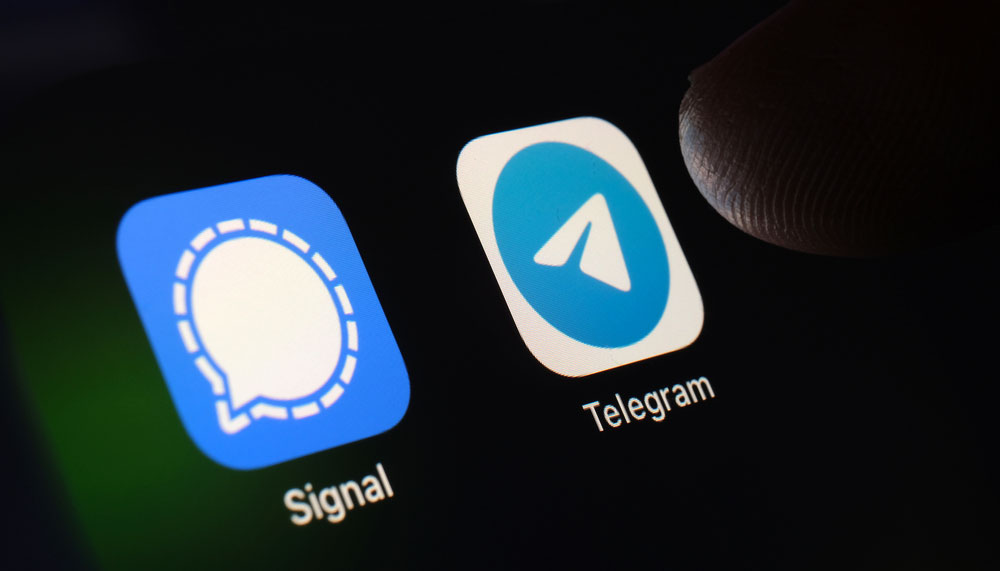Signal vs. Telegram: Which encrypted messaging app wins?
Signal and Telegram each have their strong points and their weak points

Once WhatsApp began forcing users to share data with Facebook last year, there was a large exodus from the popular chat app with many users turning to other free messaging platforms to communicate instead. Signal and Telegram are two of the most popular alternatives and they are both featured on our list of the best encrypted messaging apps.
However, Signal and Telegram have several key differences and will likely benefit different types of users. Let’s see how they stack up against each other.
Signal vs. Telegram: Features compared
| Header Cell - Column 0 | Signal | Telegram |
|---|---|---|
| Encryption | End-to-end by default using the Signal Protocol | Some end-to-end options using the MTProto 2.0 protocol |
| Data collected | None except phone number | Phone number, contacts, IP address |
| Messaging types | Individual, group, video, voice | Individual, group, channels, video, voice |
| Self-destruct messaging | Yes, for all chats | Yes, for Secret Chats only |
| Customization | Limited | Extensive |
| Cost | Free | Free |
Signal vs. Telegram: Which is more secure?
If security is your main priority, then Signal is the obvious pick. For starters, all Signal messages are end-to-end encrypted by default which means that no one but you and the people you chat with can access your messages.
With Telegram on the other hand, only some of the service’s messages and voice calls have end-to-end encryption. The rest could potentially be visible to Telegram employees, law enforcement and others. We’ll go into more detail on the different message types below.
Signal’s open-source encryption protocol is available for anyone to see and examine and as a result, any security flaws can be found and fixed quickly. It’s also worth noting that its encryption is also used by WhatsApp.
For its encrypted Secret Chats, Telegram uses its own MTProto 2.0 protocol which is open source on the client side. Many security experts have stated that Telegram’s "homegrown encryption technology" has a limited track record compared to Signal's. However, the consensus seems to be that the latest version is more secure than MTProto 1.0 (PDF).
According to an academic research paper published in 2020, Telegram’s MTProto 2.0 protocol is fundamentally sound. Still, the paper added that “further investigation” is needed “in order to deem this protocol suite definitely secure”.
Get instant access to breaking news, the hottest reviews, great deals and helpful tips.
Signal also collects far less data on users than Telegram does. Signal generally only stores the date on which you created your account as well as the last time you connected. In contrast, Telegram’s metadata may include your IP address (which can give away your location) as well as who you are talking to and when. That matters when the authorities show up at Telegram’s facilities with a search warrant.
Although you can start Signal chats by typing in another person’s phone number, Telegram requires access to your contacts before you can message anyone. For those who are concerned about tech companies snooping on their private conversations, Signal once again proves to be the better choice.
While Signal is owned by a non-profit foundation, Telegram was founded by the Russian billionaires Pavel and Nikolai Durov who also created the country’s largest social network, VK. The brothers no longer live in Russia and even though their company is based in London, many of its central operations are in Dubai.
Signal vs. Telegram: Device support
Telegram has a slight edge in this category, with a Chrome browser extension and a fully web-based option. Both Signal and Telegram are available on the following platforms:
Linux (Debian-based distros for Signal, 32-bit and 64-bit versions for Telegram)
Signal vs. Telegram: Installation and ease of use
The installation process for both apps is relatively simple: Download the software for your preferred platform, register using your phone number, and enter the verification code received via SMS. (In some cases, Telegram will call you with the code instead.)
Both platforms require a first name to finalize your profile, but neither require that name to be your real name. You can use an alias or, with Signal, an emoji. You'll be asked whether you want to enable app permissions, such as access to your contacts.
Signal then requires you to create a PIN. This step is optional, but recommended, with Telegram and can be found under Settings > Privacy & Security > Passcode Lock.
Before you can enable a desktop version of either Signal or Telegram, you must set up your account via the mobile app. Signal has an in-app QR code for linking other devices. Telegram provides a similar QR code, but you can also use your phone number and an SMS verification code.
Until earlier this year, Signal required you to create a new account if you changed your phone number. It now permits you to port your account to a new number provided you're still using the same phone. (You can also move your account to a new phone that uses the same number as the old one, as long as you're not switching from Android to iOS or vice versa.)
Changing phone numbers in Telegram is a lot easier and can be done right within the app. Changing phones isn't a problem at all, as multiple devices can be logged into a single Telegram account as long as they use the same phone number. (But you'll want to keep your Telegram password a very close secret.)
Signal vs. Telegram: Features
Both apps are similar when it comes to chat options.
Individual messages: Signal's individual messages are encrypted end-to-end by default, while Telegram's basic one-on-one chats are not. If you want to protect your communications in Telegram from the company itself, you'll have to start a Secret Chat.
Group chats: Both platforms offer a group messaging option. Again, Signal's is end-to-end encrypted, while Telegram's is not. (There's no Secret Chat equivalent for groups.) Signal groups can include up to 1,000 users while Telegram allows up to 200,000 group members.
Voice and video calls: Both platforms have voice and video calling. Signal's encrypted calls can be made individually or contain up to 40 users in a group.
Telegram has end-to-end encrypted, one-on-one video calling as well as a voice-chat feature that allows large groups to hold conversations in which members can come and go. Telegram's group voice chats are encrypted from the client device (i.e., a phone or desktop) to the server, but not from one end to the other. This means that someone who has access to Telegram's servers can listen in.
Disappearing messages: Signal messages in any individual or group chat can be set to disappear within anywhere from five seconds to one week. Telegram has a similar self-destruct option that is no longer only for Secret Chats, but also for regular chats.
From there, the bonus privacy features differ slightly, and Signal has fewer of them. There's an image-blur tool that allows you to hide faces in photos and videos — handy if you're sending media from protests. There's also a screen-lock setting that requires your password or biometric access to open the app. (Telegram has one too.)
With Telegram, you can opt to delete payment or shipping information communicated in your chats, to unsend messages (which deletes them for both the sender and the recipient), and to self-destruct your account automatically if it goes unused for a set period of time.
Telegram also operates more like a social-media network with its Channels function and a bunch of other settings we'll get into below.
Channels allow users to broadcast messages — including text, photos, videos, files and podcasts — to an unlimited number of subscribers. The communication is one-way, like a radio station, and subscribers can't respond to channel messages. Channels can be public or private/invite-only.
Signal vs. Telegram: User experience
Telegram has a lot more options to customize your experience, so in that sense, it's the frontrunner in this category. There are a ton of settings you can adjust around font size and color themes; emojis and animations; and notifications.
The app will create playlists if you send multiple song files at once and launch them in its built-in media player. You can run polls and quizzes, edit photos and videos, and view other users who happen to be physically near you with People Nearby (not a privacy-friendly feature).
Signal is a much simpler app that focuses on sending basic text, media and voice messages securely, although it introduced animated stickers and added to its available emojis. Overall, Signal is easy to navigate and doesn't require a lot of customization to get the most out of your experience.
Signal vs. Telegram: Verdict
Ultimately, the choice between Signal and Telegram depends on your priorities. If security and encryption are at the top of your list, Signal is the best option no matter which other features you use.
If you want to be able to send encrypted messages only on occasion and make use of social-network-style features, then Telegram may be a better fit. Just keep in mind that you must actively select Telegram's Secret Chat option if you want your communications to be end-to-end encrypted.

Anthony Spadafora is the managing editor for security and home office furniture at Tom’s Guide where he covers everything from data breaches to password managers and the best way to cover your whole home or business with Wi-Fi. He also reviews standing desks, office chairs and other home office accessories with a penchant for building desk setups. Before joining the team, Anthony wrote for ITProPortal while living in Korea and later for TechRadar Pro after moving back to the US. Based in Houston, Texas, when he’s not writing Anthony can be found tinkering with PCs and game consoles, managing cables and upgrading his smart home.
